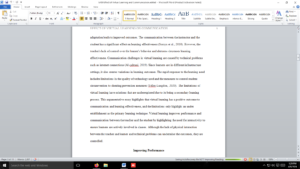Effect of Virtual Learning
- Purpose: to persuade audience to accept a claim about a debatable issue
- Audience: specific/narrow group who can make change regarding this issue, e.g. state or local government
- Voice: Third-person (no “you” voice; limited “I” voice for personal stories/examples)
- Length: 1,800+ words (not including References page)
- Citations: APA parenthetical/in-text citations throughout and APA References page com Score: 5-20% range.
- Sources: 8 or more research sources used and cited within the essay (and on the References page)
- 3+ peer-reviewed scholarly articles from the library databases
- 2+ magazine/newspaper/government document/book/eBook sources (or peer-reviewed articles)
- 2+ other credible sources, such as more general websites (may include any of the more credible source types above)
- 1+ personal interview
A Successful Argument Essay*
- Essay is persuasive, utilized rhetorical devices, demonstrating largely effective logical and persuasive skill.
- Essay is directed at a specific/narrow audience.
- Successful focus on topic and stance; thesis is a viable, well-worded opinion (claim + reasons format) leading to focused argument.
- Thesis and body strongly aligned throughout: flows in an organized manner that matches the thesis “map.”
- Utilizes topic sentences, transitions, etc. well and paragraph content is focused, purposeful, and smooth.
- Support is extensive, varied, and sophisticated throughout the paper:
- Informs audience about the background/context of the issue.
- Offers strong support for thesis by developing the reasons listed in the thesis.
- Cites and incorporates evidence from multiples sources for each reason.
- Employs research from at least 8 credible sources, meeting requirement. Sources are current (published within last five years).
- Synthesizes research with writer’s own ideas.
- Source materials are smoothly integrated with successful interpretation/accreditation; avoids “dropped”/”dumped” quotations.
- Successfully synthesizes opposing points-of-view, i.e. fairly acknowledges and responds to possible counterarguments.
- Cites paraphrases, summaries, and quotations with APA parenthetical citations.
- Point-of-view is appropriate and sustained with third-person voice.
- Language usage, voice, style, and tone are appropriate and effective; insignificant padding, redundancy, and/or overstatement.
- Errors in surface features largely non-existent; minor errors do not distract from reading.
- Is double-spaced, alphabetized, and indented as prescribed by APA conventions, uses level headers to separate sections of content for ease of reading.
- Meets the length requirement of 1,800 or more words.
- Has a Turnitin.com originality score in the 5-20% range, meaning a relatively small portion of the essay contains direct language from others/outside source, minimally repurposes previous work. Should you need to repurpose prior work from English 101, or another class, please inform your instructor of your intentions to do so.
- References page included in same document as the essay, as the final page.
- Contains citations in proper and consistent APA format (6th edition).
- Is double-spaced, alphabetized, and indented for second and following lines of each entry.
- Is relatively free of errors in punctuation and mechanics.
Answer preview
Some students who are actively engaged in virtual learning would achieve low results based on the dependence on the teacher for the dissemination of knowledge. Also, the students in a virtual environment are less anxious, feel less intimated, and speak more freely than they would in a class meeting (Ashford, 2020). In virtual learning, the teacher can interact freely with individual students to identify their weaknesses and respond accordingly. Students can also engage the online databases more actively, hence improving their knowledge base (Telles-Langdon, 2020). The increased participation and the maximum utilization of the resources available on the internet lead to an improved outcome for each student. Virtual learning is thus effective in improving the learning outcome for all programs by utilizing students’ competencies acquired in the social systems.
[2087 Words]

Effect of Virtual Learning

